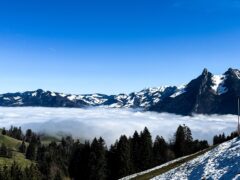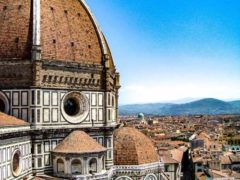This is a brief report from the final stop of our July/August tour. We have taken a detour to Poland! From Berlin, it is only 2 hours to the Polish border (and only 3.5 hours to my hometown of Koszalin). We have spent majority of our time at the Baltic coast, with quick stop in central Poland before flying back home. To give you a fuller picture of Poland, I have added info about my trip to Krakow in 2019.
The Baltic Sea
The Baltic Coast
We left Berlin in the morning. After three hours of the Autobahn driving, we have arrived at the coast of the Baltic Sea. This region of Poland is called Pomorze (Pomerania in German) and literally means “land by the sea.” For many Europeans, this part of Poland is the most desired summer destination in all of central Europe. This region has 4 major seaports, 26 working lighthouses (many of which are open to visitors), countless pristine beaches and lakes, and seaside resorts for all kinds of travelers. My favorite stop is the small resort of Mielno (just 3 miles from my home town of Koszalin). Crowds here are few, beaches are never crowded, and seafood is always fresh and very inexpensive. Plus the sunsets here are as beautiful as in Oklahoma!
Our nexts stop was historical and cultural must-see city of Gdansk (Danzig in German). The perfect place to start exploring the city is the picturesque Long Lane that spans the city centre and showcases scenic landmark after scenic landmark. Both the Golden Gate and Green Gate that book-end the street are pure works of art, as is nearly every house that lines the Long Market. Wander northward and you’ll be treated to the beautiful Beer Street (great eateries and pubs) and Amber Street with its numerous amber jewelers. Between the two you’ll find the Basilica of St. Mary with her stunning tower that offers unparalleled views of Gdansk.
Central Poland
Next, we travelled to the middle part of Poland. Our first favorite stop is Torun, home to famed astronomer Nicolaus Copernicus! This medium-sized city has a memorable historic center, next to the banks of the Vistula River. Make sure to linger in the Old Town Market Square and take in each of its brilliant brick buildings, from the old post office to the Artus Court. In the middle of it all, the Town Hall hosts an enlightening city museum and its narrow tower provides spectacular city views. Other noteworthy landmarks down the charming medieval streets include the Copernicus House where he was born in 1473, plus a number of churches and cathedrals, each worth a look.
Our final stop is Warsaw, the capitol of Poland. The best spot to start the city visit is the towering Palace of Culture and Science and its observation deck. With sublime views out across the city, it also helps you get your bearings by identifying the city’s landmarks and points of interest. From the city center, a walk along Nowy Świat takes you past dozens of historic palaces and elegant buildings. This includes the grand Presidential Palace, the seat of Poland’s president, and numerous stately churches and monuments. You can learn more about the city’s tragic Jewish history at the Museum of the History of Polish Jews or with a walking tour that leads you through the city’s WWII ghetto. A lighter option is to venture to the far bank of the Vistula River and explore the alternative Praga neighborhood. This bohemian district almost feels like a different city, which it actually was for a long time. It is said that many locals still treat it that way (similar to Buda and Pest districts being two distinct parts of Budapest).
Southern Poland
Krakow, Poland
My favorite Polish city, the darling of Poland, is the exquisite township of Krakow. It is rare to hear a bad thing said about this delightful, historic city. Unscathed physically through WWII, Kraków is very authentic, almost unchanged by time. A true highlight of Kraków is the city’s Main Square that lies at the heart of the wonderfully preserved Old Town. Here you’re introduced to some of the city’s most superb icons, such as the grand Cloth Hall and uneven St Mary’s Basilica with its hourly trumpet call. The troubled part of the city is found in the district of Kazimierz where you can learn about actions undertaken within Kraków against Jewish victims. It is here that you can tour Oskar Schindler’s Factory (of Schindler’s List fame). The haunting memorial in Ghetto Heroes Square is not to be missed. From Krakow, you can take a short trip to Auschwitz Birkenau. This infamous double Nazi death camp tells the heartbreaking story of pain and suffering (Note: this part of the trip may not be for everybody, as it can be an emotionally taxing experience).
Lessons Learned
- German is the most frequently used foreign language in Poland, with English being close second. You can expect English to be the first foreign language in Warsaw and in Krakow while German dominates in Gdansk and the Baltic Sea coast. Majority of younger people speak English while the older generation has more awareness of German and/or Russian.
- It is best to visit Poland with a trusted guide (= I am available!) who knows Polish and who can make sense of local customs and norms; while Poland is an important European country, it is culturally very eccentric and fiercely grounded in her cultural norms and history. Those who travel to Poland are treated as guests rather than tourists; we are expected to respect cultural norms and customs of the host nation.
- A visit to Poland is a huge sensory experience. The coastline of the Baltic Sea has some of the nicest beaches, without crowds, and fish and chips that rivals the taste of any that I have had in the UK! Gdansk is the birthplace of the Solidarity movement, the Polish resistance that brought about the end of communism. Gdansk is also a major historical stop where the very first battle of the World War II took place on September 1, 1939.
- Warsaw is a very modern capitol of Poland that is easy to navigate, with small, walk-friendly old city, and very hospitable and friendly people.
- Old Krakow is the most picturesque historical Polish city, with the royal palace, the university dating back to 14th century and extensive, old town that takes you back to the medical times!
- Food in Poland is incredible and inexpensive! Overall, Poland is not as expensive as the rest of Europe and so it is a desired holiday destination for many Europeans.
Selected resources that I found helpful preparing for this trip:
- http://gotopoland.eu/explore-poland/polish-baltic-coast-will-surprise.html
- https://handluggageonly.co.uk/2020/01/29/14-best-things-to-do-in-gdansk-poland/
- https://theculturetrip.com/europe/poland/articles/the-best-things-to-see-and-do-in-torun-poland/
- https://www.nationalgeographic.com/travel/2019/07/the-utlimate-weekend-itinerary-krakow-poland-europe/
Krakow, Poland Aushwitz Polish Pancakes


